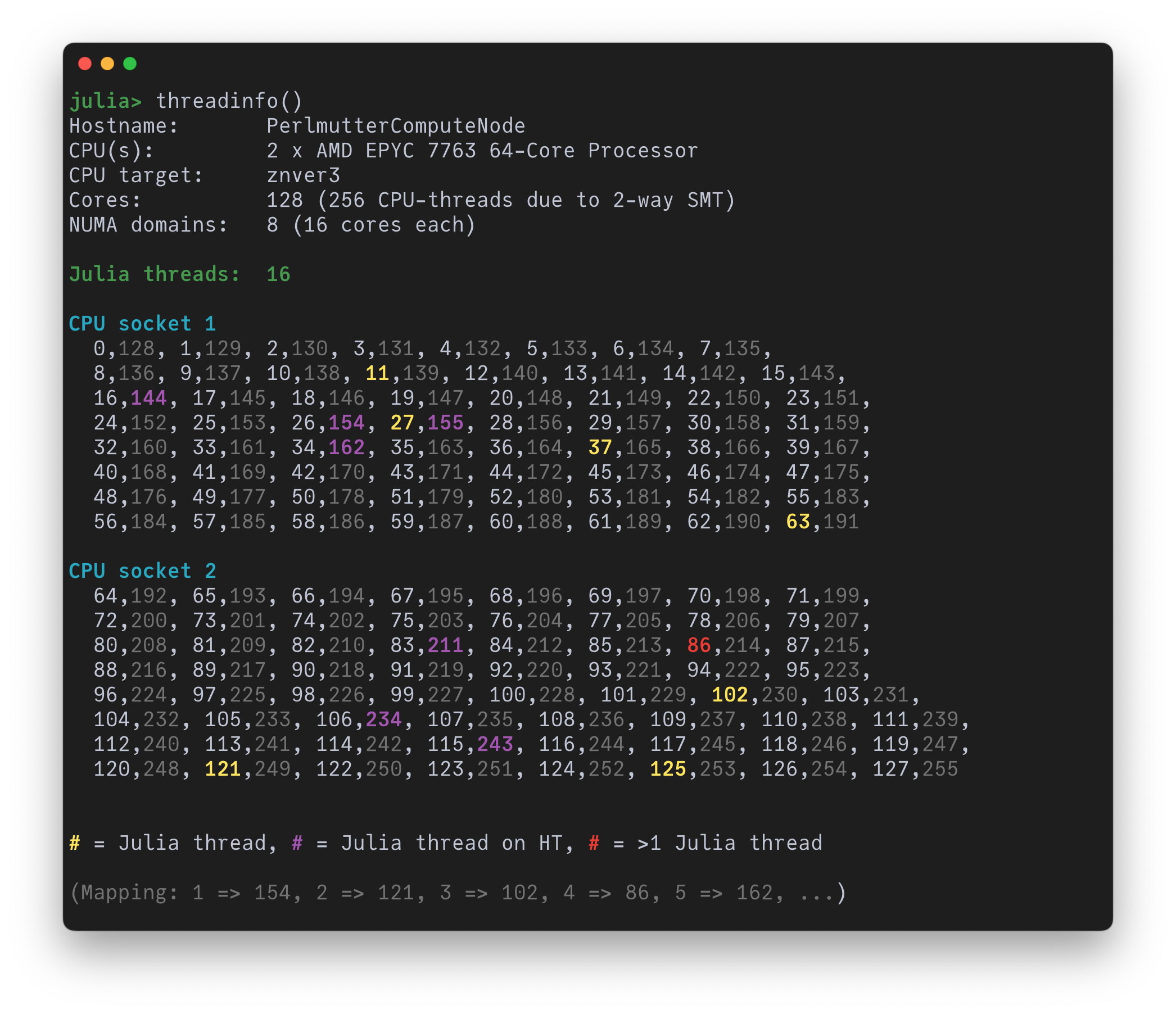Pinning Julia Threads
The most important functions are pinthreads and threadinfo. The former allows you to pin threads. The latter visualizes the current thread-processor mapping and the system topology. Please check out the comprehensive documentation of these functions for detailed information.
Typical usage
pinthreads
Pinning your threads is as simple as putting the following at the top of your Julia code:
using ThreadPinning
pinthreads(:cores)This will successively pin all Julia threads to CPU-cores in logical order, avoiding "hyperthreads" if possible. Of course, you can replace :cores by all the options supported by pinthreads. Conceptually, there are three different formats to specify your desired thread-processor mapping:
- predefined symbols (e.g.
:coresor:sockets), - logical specification of domains via helper functions (e.g.
nodeandsocket), - explicit lists of CPU IDs, e.g.
0:3or[0,12,4](as the OS defines them).
For example, instead of pinthreads(:cores) above, you could write pinthreads(:sockets), pinthreads(socket(1,1:3), numa(2,2:5)), or pinthreads(1:2:10). See pinthreads for more information.
threadinfo
To check and visualize the current placement of threads you can use threadinfo.

As you can see, this image is taken on a dual-socket system where each CPU has 64 CPU-cores and Julia has been started with 5 threads. Hyperthreading is enabled with two CPU-threads per core (the greyed out numbers indicate hyperthreads/SMT-threads and the gap between numbers indicates different cores).
Notably, the threads aren't pinned. Not only are they randomly placed on the system but two of them do even overlap in the sense that they are currently both running on the same CPU-thread, leading to contention.
If we pin threads to different cores (pinthreads(:cores)) and call threadinfo() again we obtain this:

Keyword options
Note that threadinfo has quite a number of keyword arguments that let you change or tune the output. The most important one is probably groupby. It allows you to switch from socket to, say, NUMA/memory domain visualization (groupby=:numa).
julia> pinthreads(:numa) # round-robin distribution among NUMA domains
julia> threadinfo(; color=false, groupby=:numa) # grouping by NUMA domains (instead of CPU sockets)
Hostname: PerlmutterComputeNode
CPU(s): 2 x AMD EPYC 7763 64-Core Processor
CPU target: znver3
Cores: 128 (256 CPU-threads due to 2-way SMT)
NUMA domains: 8 (16 cores each)
Julia threads: 16
NUMA domain 1
0,_, 1,_, _,_, _,_, _,_, _,_, _,_, _,_,
_,_, _,_, _,_, _,_, _,_, _,_, _,_, _,_
NUMA domain 2
16,_, 17,_, _,_, _,_, _,_, _,_, _,_, _,_,
_,_, _,_, _,_, _,_, _,_, _,_, _,_, _,_
NUMA domain 3
32,_, 33,_, _,_, _,_, _,_, _,_, _,_, _,_,
_,_, _,_, _,_, _,_, _,_, _,_, _,_, _,_
NUMA domain 4
48,_, 49,_, _,_, _,_, _,_, _,_, _,_, _,_,
_,_, _,_, _,_, _,_, _,_, _,_, _,_, _,_
NUMA domain 5
64,_, 65,_, _,_, _,_, _,_, _,_, _,_, _,_,
_,_, _,_, _,_, _,_, _,_, _,_, _,_, _,_
NUMA domain 6
80,_, 81,_, _,_, _,_, _,_, _,_, _,_, _,_,
_,_, _,_, _,_, _,_, _,_, _,_, _,_, _,_
NUMA domain 7
96,_, 97,_, _,_, _,_, _,_, _,_, _,_, _,_,
_,_, _,_, _,_, _,_, _,_, _,_, _,_, _,_
NUMA domain 8
112,_, 113,_, _,_, _,_, _,_, _,_, _,_, _,_,
_,_, _,_, _,_, _,_, _,_, _,_, _,_, _,_
# = Julia thread, # = Julia thread on HT, # = >1 Julia thread
(Mapping: 1 => 0, 2 => 16, 3 => 32, 4 => 48, 5 => 64, ...)
There is much more, though. Rather than Julia threads you can highlight BLAS threads (after you've pinned them) with blas=true. If you're in a SLURM allocation, you might want to give slurm=true a try. For more, please check out the threadinfo() documentation.
Unpinning
We provide functions unpinthread(threadid) and unpinthreads() to unpin a specific or all Julia threads, respectively. This is realized by setting the thread affinity mask to all ones.
As an alternative, you might also want to consider using pinthreads(:random) for "fake unpinning". While technically not really unpinning the threads, it's often a better choice (e.g. for benchmarks) as it does randomize the thread placing but keeps it fixed to reduce fluctuations.
Default pinning (for package authors)
If you're developing a package you may want to provide a reasonable default pinning. If you would naively use pinthreads for this, you would enforce a certain pinning irrespective of what the user might have specified manually. To avoid this, you can set force=false in your pinthreads call, e.g. pinthreads(:cores; force=false). This way, a user can overwrite your default pinning (:cores in this example), e.g. by calling pinthreads manually before running your package code.
JULIA_PIN environment variable
In some scenarios, you may want to specify the desired pinning strategy through an environment variable rather than hardcoding it in the source code (e.g. as a strict pinthreads(:cores) call). This is possible if you set JULIA_PIN in conjuction with using pinthreads(...; force=false). This way, the hardcoded is strategy is only used if JULIA_PIN is not set. Otherwise, the value of the environment variable takes precedence. Note that JULIA_PIN may be set to any symbol that is supported by pinthreads. For now, specifying the CPU IDs manually isn't supported (please open an issue or a PR if you need this).